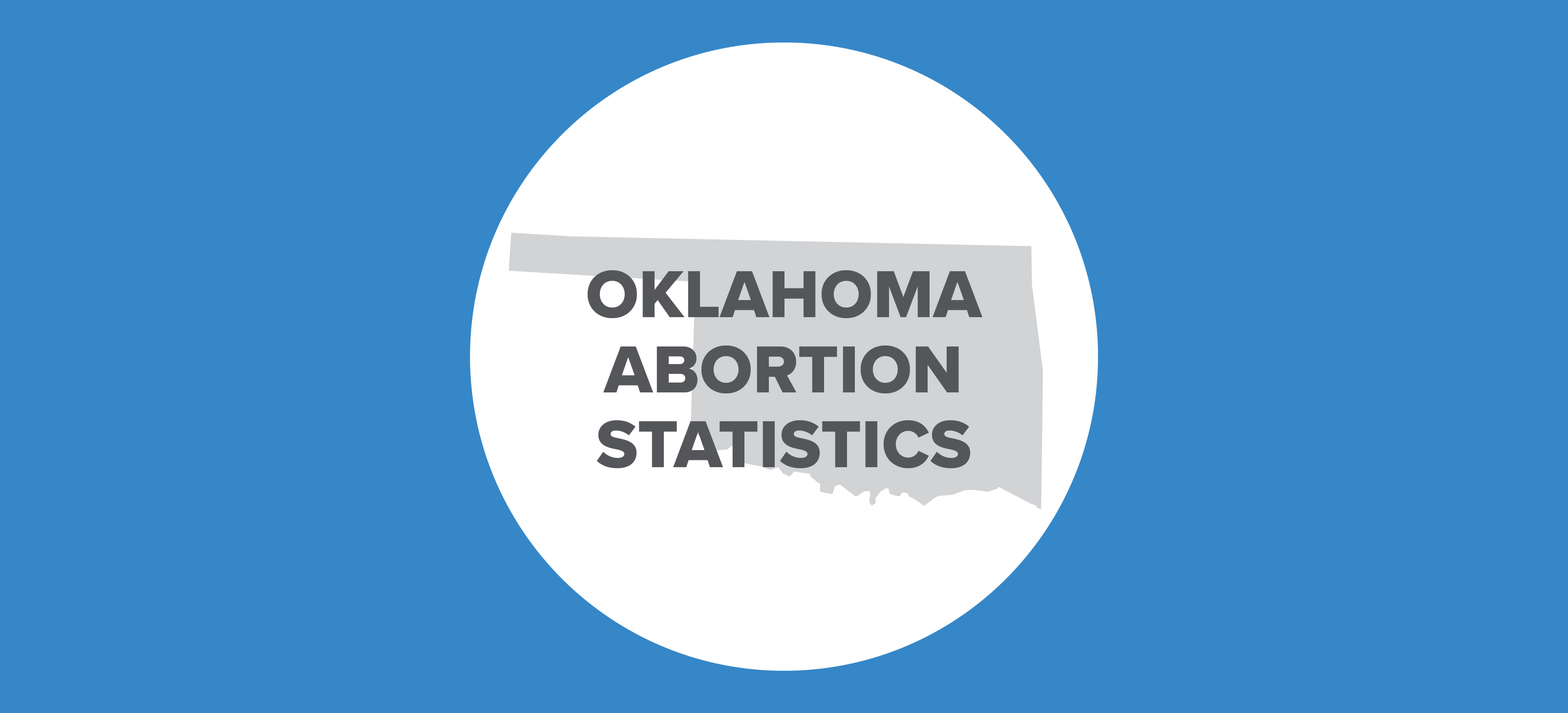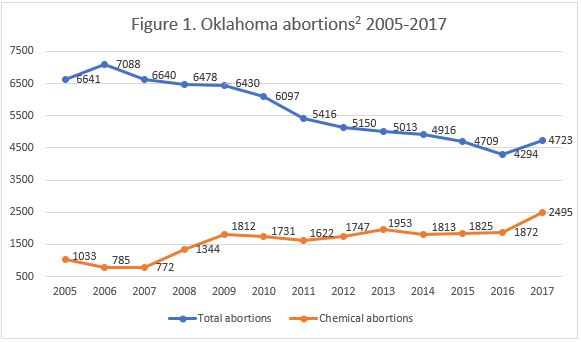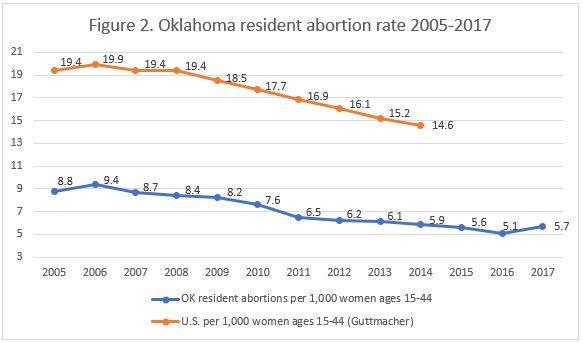Abortion Reporting: Oklahoma (2017)

Correction: Oklahoma’s ultrasound requirement is not in effect due to an Oklahoma State Supreme Court decision.
Oklahoma’s 38-page abortion report, published annually by the state Department of Health, was released in June 2018. The report, which covers calendar year 2017, reveals that abortions in Oklahoma increased after several years of decline.
Changes in Oklahoma Abortions, 2016-2017

Abortion Totals and Trends
In 2017, 4,723 abortions were performed in Oklahoma, up 10 percent from the 4,294 abortions the year before (Fig. 1). Much of that increase is likely attributable to the rise in chemical abortions since 2016. Chemical abortions increased by 33 percent from 1,872 in 2016 to 2,495 in 2017 – or 53 percent of total abortions. Since Oklahoma first began reporting abortions in 2000, total abortions in the state have declined by 34 percent. Chemical abortions, however, have been increasing over the years. From 2002, the first year with chemical abortion data available in Oklahoma’s online vital statistics database, chemical abortions have risen by 740 percent. Oklahoma’s resident abortion rate increased from 5.1 resident abortions per 1,000 women ages 15-44 in 2016 to 5.7 in 2017 (Fig. 2). The abortion report cautions that the 2017 rate is based on 2016 population estimates and will be updated in the next report.
State Report Summary
Ninety-three percent of the women who underwent abortions in Oklahoma were Oklahoma residents. Of the remaining 329 women from out of state, 116 were from Texas and 104 were from Arkansas. In all, women from 18 different states got abortions in Oklahoma. Slightly more than half – 59 percent – were in their twenties. Eleven percent of the women getting abortions were age 19 or younger and 30 percent were age 30 or older, similar to the age distribution in other states. White women made up the largest racial group at 58 percent of abortions, although white women represent 75 percent of the total population of Oklahoma women of childbearing age. Black women were the second-largest group of women having abortions, at 20 percent. Overall, black women were 10 percent of the state population of women between the ages of 15 and 44.
Seventy-nine percent of the women getting abortions in Oklahoma were not married, compared to 21 percent who were married. The majority, 70 percent, had been pregnant before. Most had already experienced a live birth. Almost one-quarter had one previous live birth, while 37 percent had two or more. Most women (82 percent) reported no prior miscarriages. Similarly, 70 percent of women reported no past abortions. Twenty percent had one previous abortion, and 10 percent had two or more. Most women had at least a high school education – 38 percent reported a high school diploma as their highest level of education, 36 percent had completed some college, and 15 percent had a bachelor’s degree or higher. Just 11 percent had not finished high school.
Nearly three-quarters of abortions took place at less than eight weeks of gestation. Nineteen percent were performed between nine and 12 weeks, while four percent occurred between 13 and 15 weeks and three percent between 16 and 20 weeks. Twenty-one abortions were performed at 21 weeks of gestation, or approximately 19 weeks post-fertilization. Oklahoma prohibits abortions at or after 20 weeks post-fertilization – or five months of pregnancy, when babies can feel pain – unless the life or a significant bodily function of the mother is at risk. No abortions at or after 20 weeks post-fertilization (22 weeks of gestation) were reported in 2017.
During 2017, there were 29 complications reported by doctors performing abortions.1 Additional complications were reported by other physicians, although the exact number is suppressed in accordance with Oklahoma’s policy of suppressing numbers less than five to protect the identities of the women getting abortions. Multiple complications could be reported for each patient. Twenty-two instances of failed termination were reported, along with seven other unspecified complications. Hemorrhages also occurred, but the precise number is suppressed in the report. The number of babies born alive during abortions is also suppressed. As a result, it is not clear how many – or if any – babies were born alive in 2017.
Oklahoma collects women’s reasons for abortion. Each woman may give more than one reason. In 2017, zero women reported choosing abortion because of rape or incest. The numbers of abortions due to risks to the mother’s life and physical health, or because of medical emergencies requiring waivers of Oklahoma’s informed consent law, were suppressed since they were so few. In comparison, the most common reason provided by women was that “a baby would dramatically interfere with the life of the mother,” given 172 times. A close second was that the “mother is not ready for a, or another, child,” given 171 times.
Oklahoma has a robust informed consent process in place to ensure that women are fully informed before deciding to undergo an abortion. At least 72 hours before her abortion, each mother must be informed about the details of her abortion procedure, including the name of the physician, the medical risks of abortion and childbirth, and the probable gestational age of her baby. Each woman must also be made aware that resources are available to her, and that the father of her baby must help support the child financially. In 2017, information about the abortion procedure was provided to 4,711 women, and information on available support was provided to 4,709 women. The report does not indicate why the remainder of the women undergoing abortions did not receive the informed consent information. In cases of emergency, the informed consent requirements may be waived, but the number of waivers in 2017 is suppressed. The vast majority of women spoke with an agent of the physician rather than the physician himself – the exact number of women who spoke with their physician is suppressed. Eighty-one percent received the required information over the phone, rather than in person. There were 1,314 women who requested that the information be mailed to them; all 1,314 women went on to have abortions.
There were 121 minor girls who had their parents notified prior to the abortion in compliance with Oklahoma’s parental notification law. Fifty girls had their parents notified in person, and 70 by mail. All the girls went on to get abortions after their parents were informed. The report does not specify how the one remaining girl’s parents were notified. The number of emancipated minors getting abortions in 2017, as well as the medical emergencies and judicial waivers creating exceptions to the parental notification law, is suppressed.
The vast majority of abortions, 4,720, were paid for with private funds. Zero abortions were funded through insurance (as state law prohibits abortion coverage through both private plans and the Affordable Care Act marketplace plans except in the case of life endangerment). The number of abortions covered by Medicaid was suppressed. In Oklahoma, Medicaid funds abortions only in cases of risk to the life, or a significant bodily function, of the mother, or if the pregnancy is a result of rape. Over half of the abortions in Oklahoma – 57 percent – cost between 500 and 600 dollars each. Seventy percent of the doctors performing abortions specialized in obstetrics and gynecology, while 30 percent were general practice. The number of doctors with hospital admitting privileges was suppressed. Almost a third of chemical abortions were begun without the physician present. For 1,689 out of the 2,495 chemical abortions performed in Oklahoma, the doctor was in the room with the woman undergoing the abortion when the chemicals were first administered to her.
Forty percent of the women undergoing abortions received anesthesia. Ninety-nine percent of the babies killed by abortion were not anesthetized. The report does not indicate how many babies received anesthesia, although it does note that due to the gestational age of these babies, it is unlikely that they were anesthetized. Fifty percent of the babies were disposed of via medical waste, while 22 percent were incinerated, and 20 percent were discarded at home. Eight percent were disposed of using some other, unspecified method. The month of March had the highest number of abortions, 486, and February had the fewest, 338. On average, almost 394 abortions were performed each month in Oklahoma. However, Oklahoma’s 2017 report and earlier reports caution that some abortions in the state may have gone unreported.
Ultrasound and Heartbeat
According to Oklahoma law, at least one hour before an abortion is performed, the physician must perform an ultrasound, allow the woman to view it, and explain what she is seeing.* In 2017, ultrasounds were performed before all but three of the 4,720 abortions. The report does not state why ultrasounds were not used in advance of the remaining three abortions, although it is possible that the ultrasound requirement was waived in these cases due to medical emergencies. Additionally, ultrasounds were used during 559 abortions and after 556 abortions.
Before performing an abortion on a woman whose pregnancy has reached eight weeks of gestation or later, the doctor must tell the mother that it may be possible for her to listen to her baby’s heartbeat, ask her if she would like to do so, and, if she does, then make it audible for her to hear using a Doppler heart monitor. In 2017, 3,549 women had the heartbeat made audible for them to hear. Fifty-two women did not have the heartbeat made audible, and the question was marked as “not applicable” to 566 abortions. There were an additional 556 abortions not accounted for by the heartbeat section of the abortion report. Because the state report only includes information on abortions carried out, there is no way to tell from the report how many women opted to have the baby’s heartbeat made audible and subsequently decided not to go through with the abortion. In addition, because some doctors failed to fill out the heartbeat section of the abortion reporting form, information is missing for many more abortions. Still, Oklahoma has a stronger process for making the humanity of unborn children evident than many other states – only seven other states report whether ultrasounds are performed in conjunction with abortions.
State Ranking
In a Charlotte Lozier Institute study of abortion reporting across the 50 states, the District of Columbia, and New York City, Oklahoma’s reports were ranked at first place. Oklahoma’s reports are detailed and comprehensive, and the state releases them in a timely manner. However, Oklahoma could make its reports even more valuable by revising its data suppression policy, which currently renders some of the information in the report incomplete and unusable. Other states have developed procedures that allow them to protect women’s privacy while still making data available to researchers. For example, Minnesota, which was ranked at 2nd place by the CLI study, suppresses small numbers in its county of residence table to prevent women from being identified. Minnesota, however, does not hide small numbers in other categories that would be less likely to lead to the identification of a woman getting an abortion, such as gestational age or the types of complications caused by abortion. By releasing more information, Oklahoma could make its annual abortion report an even more useful resource for year-over-year and cross-state comparisons.


- Statistics on abortion complications reported here represent a minimal number of deaths and complications, as this data is collected in a non-systematic and non-verifiable way. As such, this data cannot be used to calculate either an accurate abortion mortality rate, nor an accurate abortion complication rate for the state.
- Total and chemical abortion data for 2002-2016 were taken from Oklahoma’s vital statistics database, OK2Share.
*Correction: Oklahoma’s ultrasound requirement is not in effect due to an Oklahoma State Supreme Court decision.


























